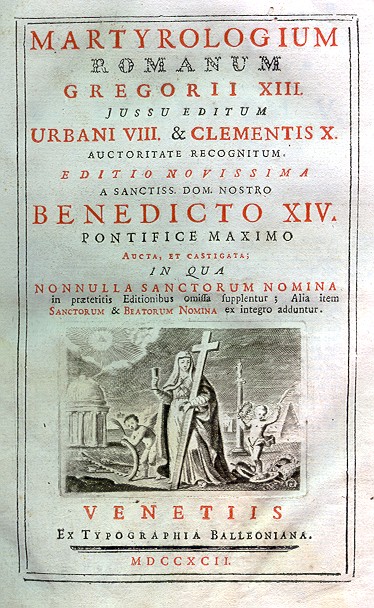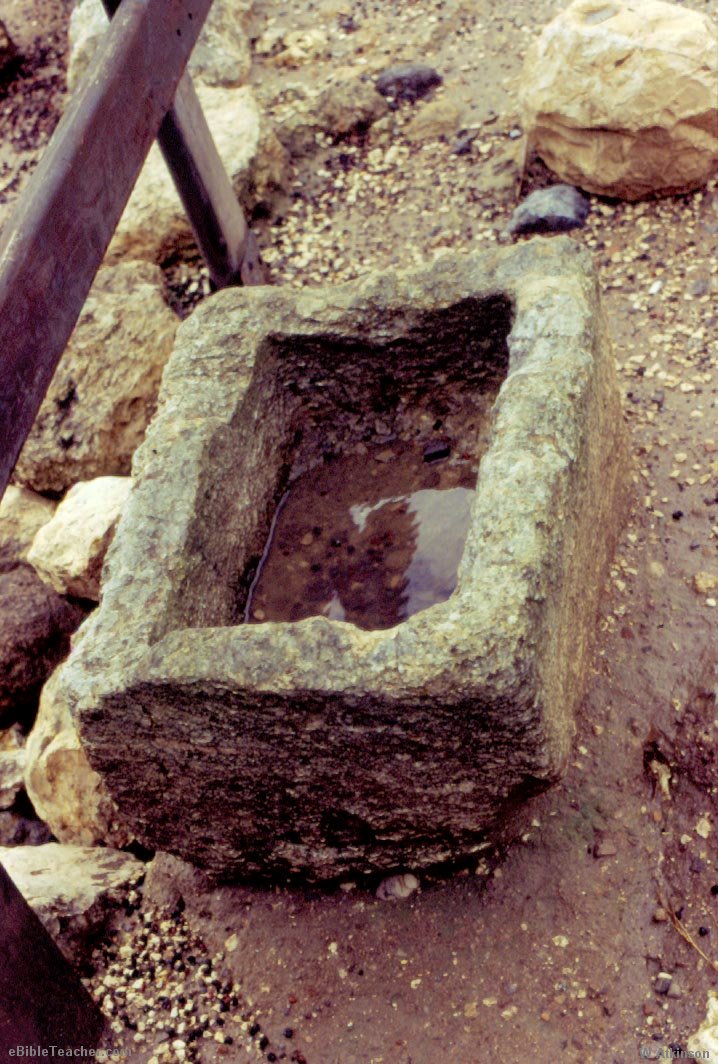
What is a Martyrology?
A martyrology (a synaxarion or menologion for the Eastern churches) is a catalogue or list of martyrs - later extended for saints in general, arranged in the calendar order of their anniversaries or feasts.
Since the time when the commemorations of martyrs, to which were added those of bishops, began to be celebrated, each local church had its special martyrology, on which the names of local Christians who were killed for their faith were listed. These local lists were further enriched by names borrowed from neighbouring localities. Consolidation occurred, by the combination of several local martyrologies, with or without borrowings from literary sources.
In the early years of Christianity, it became customary to offer the Eucharist on the tombs of the martyrs on the anniversary of their deaths; i.e. their birthday into Heaven. At this meeting, the local bishop, or one from a neighbouring community, would usually deliver an oration in praise of the martyr. The Acts of the trial and passion of the martyr would also be recounted or, if the community possessed them, read and, later on gathered in a special book, of the miracles accomplished by the martyr since his death.
The veneration of certain saints gradually spread beyond the bounds of their churches of origin, most often because of the miracles worked through their relics. These attracted pilgrims and the veneration of other churches who sought the martyrs' protection, particularly if they had been able to obtain some fragments of their holy relics. This led to consolidation and combination of several local martyrologies, with or without borrowings from literary sources, to produce general martyrologies, covering a wider range. The scope of martyrologies were further extended when the struggle against heresies produced many holy bishops and priests, and whose feasts, as confessors of the faith, were added to those of the martyrs.
These martyrologies either took the form of a simple list of names, or may also include small biographical details about a particular saint (these types of martyrologies were called historical martyrologies).
The Latin rite of the Catholic Church uses what is called the Roman Martyrology (Martyrologium Romanum in Latin). The main source for this was the Martyrology of Usuard, completed by the Dialogues of Pope Gregory the Great and the works of some of the Fathers, and for the Greek saints by the catalogue known as the Menologion of Sirlet. Its origins can be traced back to the Martyrologium Hieronymianum, which was originally based on calendars of Roman, African and Syrian provenance, but to which were gradually added names of many saints from other areas, resulting in a number of duplications, fusions of different saints into one, and other mistakes.
The Roman Martyrology was first published in 1583 by Pope Gregory XIII, who in the year before had decreed the revision of the Julian calendar that is called, after him, the Gregorian calendar. A second edition was published in the same year. The third edition, in 1584, was made obligatory wherever the Roman Rite was in use. Very soon, in 1586 and again in 1589, revised editions were published with corrections by Caesar Baronius along with indications of the sources on which he drew, and in 1630 Pope Urban VIII issued a new edition. Pope Benedict XIV was also interested in the Roman Martyrology: his bull of 1748 addressed to John V, King of Portugal, long prefaced printings of the Roman Martyrology.
1748 saw the appearance of a revised edition by Pope Benedict XIV, who personally worked on the corrections: he suppressed some names, such as those of Clement of Alexandria and Sulpicius Severus, but kept others that had been objected to, such as that of Pope Siricius. Subsequent changes until the edition of 2001 were minor, involving some corrections, but mainly the addition of the names of newly canonized saints. The current (2005) edition, which corrected a number of typographical errors that appeared in the 2001 edition and added 117 people canonized or beatified between 2001 and 2004, contains about 7,000 saints and blesseds currently recognized and venerated by the Church.
A sample entry from the Roman Martyrology would look like this (taken from the 1956 Roman Martyrology):
The 1st day of January. The Kalends of January.A sample entry from a calendar-type synaxarion (which is a mere listing of saints arranged in the order of their anniversaries), meanwhile, would look like the following:
The Circumcision of our Lord Jesus Christ, and the octave of his Nativity.
At Rome, under Emperor Alexander, St. Martina, virgin, who endured various kinds of torments, and being beheaded, received the palm of martyrdom. Her feast is kept on the 30th of this month.
At Caesarea in Cappadocia, the death of St. Basil the Great, bishop, confessor, and doctor of the Church, renowned for his learning and wisdom and gifted with every virtue, who during the reign of Emperor Valens wonderfully displayed his talents as he defended the Church with great constancy against the Arians and Macedonians. His feast, however, is appropriately kept on the 14th of June, the day on which he was consecrated bishop.
In Tuscany, on Mount Senario, St. Bonfilius, confessor, one of the seven founders of the Order of the Servites of the Blessed Virgin Mary, who, having honoured her devoutly, was suddenly called to heaven by her. His feast, with that of his companions, is kept on February 12th.
At Rome, St. Almachius, martyr, who, by the command of Alipius, governor of the city, was killed by the gladiators for saying, "Today is the Octave of our Lord's birth; put an end to the worship of idols, and abstain from unclean sacrifices."
In the same city, on the Appian Way, the crowning with martyrdom of thirty holy soldiers under Emperor Diocletian.
At Spoleto, in the time of Emperor Antoninus, St. Concordius, priest and martyr, who was beaten with clubs, then stretched on the rack, and after a long confinement in prison, where he was visited by an angel, lost his life by the sword.
The same day, St. Magnus, martyr.
In Africa, St. Fulgentius, bishop of Rusp, who suffered much from the Arians, during the persecution of the Vandals, for holding the Catholic faith and teaching an excellent doctrine. After being banished to Sardinia, he was permitted to return to his diocese, where he ended his life by a holy death, leaving a reputation for sanctity and eloquence.
At Chieti in Abruzzo, the birthday of St. Justin, bishop of that city, illustrious for holiness of life and for his miracles.In the diocese of Lyons, in the monastery of St. Claude, St. Eugendus, abbot, whose life was eminent for virtues and miracles.
At Souvigny in France, St. Odilo, abbot of Cluny, who was the first to prescribe that the commemoration of all the faithful departed should be made in his monasteries the day after the feast of All Saints. This practice was afterwards received and approved by the universal Church.
At Rome, the birthday of St. Vincent Maria Strambi, Bishop of Macerata and Tolentino, of the Order of Passionists, renowned for his pastoral zeal, whom Pope Pius XII numbered among the saints.
At Alexandria, the departure from this world of St. Euphrosyna, virgin, who was renowned in her monastery for the virtue of abstinence, and for the gift of miracles.
¶ And elsewhere in divers places, many other holy martyrs, confessors, and holy virgins.
R. Thanks be to God.
January
1. The Circumcision of Our Lord and Savior Jesus Christ.
Basil the Great, Archbishop of Caesarea.
Peter the Neomartyr.
 In the 10th century, scribes began to including biographical notices to these simple calendar listings. As the lessons in the Byzantine Divine Office are always lives of saints, the synaxarion became the collection of short lives of saints and accounts of events whose memory is kept. Another name for these synaxaria containing brief lives of the saints is the Prologue, a term which did not remain in popular use in the Byzantine church, but which remained popular among the Slavic nations. Essentially, the Slavonic Prolog (traditionally published in 4 volumes containing brief lives of the saints for 3 months per volume) and the modern Greek synaxarion are the same, or at least analogous, collections.
In the 10th century, scribes began to including biographical notices to these simple calendar listings. As the lessons in the Byzantine Divine Office are always lives of saints, the synaxarion became the collection of short lives of saints and accounts of events whose memory is kept. Another name for these synaxaria containing brief lives of the saints is the Prologue, a term which did not remain in popular use in the Byzantine church, but which remained popular among the Slavic nations. Essentially, the Slavonic Prolog (traditionally published in 4 volumes containing brief lives of the saints for 3 months per volume) and the modern Greek synaxarion are the same, or at least analogous, collections.A sample entry would very much look like this:
JANUARY
This month has thirty-one days with ten hours of day fourteen hours of night.
The Circumcision according to the flesh of Our Lord Jesus Christ; and commemoration of our Father among the Saints Basil the Great, archbishop of Caesarea in Cappadocia.
Since the law of Moses lays down that if a woman gives birth to a male child it shall be circumcised in the flesh of its foreskin on the eighth day, for this reason our Savior on the present day, which is the eighth from his Nativity, accepted the Circumcision prescribed by the law, and received, in accordance with the Angel’s command, the name which is above every name, "Jesus", that is to say, Savior. As we celebrate our Lord’s name day today, from it we begin the New Year from his incarnation.
Saint Basil the Great belonged, through his father also named Basil, to the province of Pontus, and through his Emmelia, to the province of Pontus, and through his mother Emmelia, to Cappadocia. He was born in Caesarea in Cappadocia around 329-330. He studied in Caesarea, then in Constantinople under the famous rhetor Libanius, and finally in Athens, where he became a close friend of Saint Gregory of Nazianzus. Shortly after his return to Caesarea which occurred about 356, he retired in solitude to the outskirts of Neocaesarea, where his mother and his sister Macrina already led the monastic life. It is at that time he composed his ascetical writings. He was ordained a priest by Eusebius, Archbishop of Caesarea, and at the death of the latter was elected in 370 to succeed him and rule the Church of Christ. He governed it for eight years, during which time he proved himself a witness of the truth in the face of heresy and full of courage before the threats of the Arian Emperor Valens. He died on January 1, in the year 379. The wisdom and the learning which fill his works, his Philokalia (extracts from the works of Origen), his Treatise on the Holy Spirit, his theological work against the Arian Eunomius, his ascetical writings, his monastic rules, his commentaries on Sacred Scripture, the panegyrics which he made of many saints, his correspondence, and finally the splendor and the force of his words, have won for him rightly the epitaphs of "Revealer of Heaven," and of the "Great."









